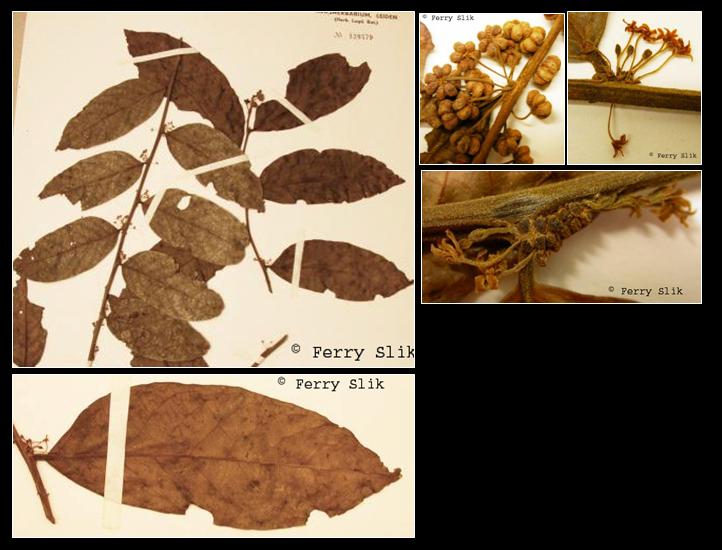Glochidion glomerulatum (Miq.) Boerl., Handl. 3, 1 (1900)
Latin for 'bundle of flowers'.Synonyms
Agyneia glomerulata Miq.
Bridelia heterantha Wall. [Invalid]
Diasperus glomerulatus (Miq.) Kuntze
Diasperus heteranthus Kuntze
Diasperus nanogynus (M¨šll.Arg.) Kuntze
Glochidion nanogynum (Mull.Arg.) Hook.f.
Glochidion palustre Koord.
Phyllanthus glomerulatus (Miq.) Mull.Arg.
Phyllanthus nanogynus Mull.Arg.
Diagnostics
Shrubs to small tree up to 8 m tall and 6 cm dbh. Stipules ca. 2 mm long.
Leaves alternate, simple, penni-veined, glabrous to slightly hairy. Flowers ca.
3 mm diameter, white-yellowish, placed in axillary bundles. Fruits ca. 4 mm
long, reddish-orange, dehiscent capsules, seeds with red aril.
Description
Shrubs to treelets up to 8 m high, dbh up to 6 cm; branches drooping, flowering twigs c. 2 mm
thick; mainly glabrous all over. Leaves: stipules deltoid, c. 2.3 by 1.5 mm, acute, stiff, caducous;
petiole 5-7 mm long; blade ovate to elliptic, 6.1-13 by 2.3-4.7 cm, length/width ratio 1.4-2.8,
papery to subcoriaceous, base strongly asymmetric, long attenuate along whole petiole, margin flat,
apex acuminate, mucronate, both surfaces glabrous, venation flat above, slightly raised underneath,
indistinct, nerves 9-11 per side, veins reticulate. Inflorescences fascicles with either 3-10
pistillate flowers or a mixture of a few staminate and many more pistillate flowers. Flowers pale
green; sepals 6, free. Staminate flowers c. 4.2 mm in diameter, pedicel 2.5-6.2 mm long, glabrous
to hirsute; sepals ovate to elliptic, outer ones 2.5-3.5 by 0.9-1 mm, inner ones 2.5-3.3 by
0.7-0.9 mm; stamens 3, androecium 1.2-1.6 mm long, anthers 0.9-1.2 mm long, light yellow to grey,
connective teeth 0.2-0.3 mm long. Pistillate flowers 2.5-4 mm in diameter; pedicel absent to up
to 1.4 mm in fruit; sepals ovate to elliptic, outer ones 0.9-1.2 by 1-1.1 mm, inner ones 1.3-1.5
by c. 0.8 mm; ovary 6-locular, 1.4-3.7 by 1-2 mm high, densely pilose; stigmas in a cone 1.3-1.8
by 0.6-0.8 mm high. Fruits slightly lobed, circular, flattened, c. 5 by 3.2 mm high, red to brown,
sutures indistinct, always hairy, glabrescent; wall thin; column c. 1.1 by 0.7 mm, only basal
triangle left. Seeds 2.5-2.6 by 1.5-2 by c. 2 mm, brown. [from Flora Malesiana]
Ecology
In undisturbed to slightly disturbed mixed dipterocarp, freshwater swamp and
sub-montane forests up to 1700 m altitude. Often along rivers and alluvial sites
but also on hillsides and ridges with sandy to clay soils.
Uses
The leaves are used as an ingredient to dye rattan black.
Distribution
Indo-China, Thailand, Peninsular Malaysia, Sumatra, Java, Borneo.
Local names
Borneo: Dampol, Kayu julot, Manyam, Obar nasi, Salman.
Thailand: Ka thin (Yala), Rot nam (Surat Thani).
